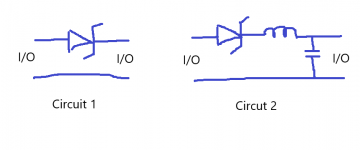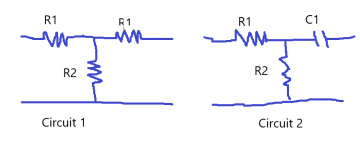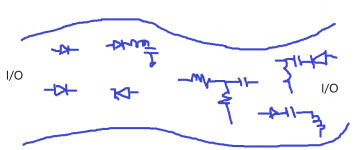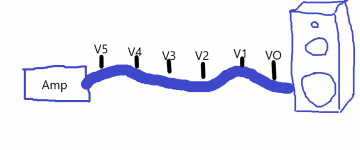Let us go then, you and I ...
Oh, do not ask, “What is it?”
Let us go and make our visit.
I attached two circuits below. Which one would be symmetric and which one is not? Symmetric I mean if I connect the sine wave source one end, then measure the output on the other end, then swap end in term of source and output, would the output be different? Notice exercise only applies to pure sine wave.
Here are the options:
1. Both are symmetric
2. Both are non-symmetric
3. Only circuit 1 is symmetric
4. Only circuit 2 is symmetric
Attachments
Last edited:
So the next thing is I am going to place these circuits in my post #1 and post #2 into a conductive three dimensional structure, let's call it a metal structure, what would happen? Would the signal from left to right, right to left be symmetric?
See my drawing below. OK, I am using a crappy Paint program so hopefully I can rely on your imagination.
Please also keep in mind that the metal structure is a 3-dimensional structure (but Paint can only allow me drawing in 2D), so even if some of the circuits are symmetric in amplitude, the phase is not, and its phase will interact with other non-symmetric circuit, so the outcome is not easy to understand.
Let's assume that these parasitic circuits are much smaller than the metal structure in which they are imbedded, and even if they are randomly distributed, it is highly unlikely that the affects will be cancelled out.
See my drawing below. OK, I am using a crappy Paint program so hopefully I can rely on your imagination.
Please also keep in mind that the metal structure is a 3-dimensional structure (but Paint can only allow me drawing in 2D), so even if some of the circuits are symmetric in amplitude, the phase is not, and its phase will interact with other non-symmetric circuit, so the outcome is not easy to understand.
Let's assume that these parasitic circuits are much smaller than the metal structure in which they are imbedded, and even if they are randomly distributed, it is highly unlikely that the affects will be cancelled out.
Attachments
is it true that if all components are passive (R, L, C), then all circuits are symmetric
Not true. For example, circuit #2 in your post #2 is not symmetric.
Input voltage at left end gives Vout/Vin = R2/(R1+ R2)
Input voltage at right end gives Vout/Vin = [ R2/(R2 + 1/sC1) ] = sR2C1/(1+sR2C1)
Last edited:
It is possible that the amplitude portion could be symmetric,
but the phase may not be.
Not in either respect.
It would be nice if someone could post a simulation run. In term of DC, it probably is not symmetric in term of amplitude, but if the source is a sine wave, then it's hard to visualize, at least for me. If we have a simulation run, then it would be definitive with input and output waveform.
If we have a simulation run, then it would be definitive with input and output waveform.
See the circuit equations in post #6. Left and right input results are not the same,
so the circuit is not symmetric. For DC, set s=0. A capacitor does not pass DC.
Great idea! Why don't you?It would be nice if someone could post a simulation run. In term of DC, it probably is not symmetric in term of amplitude, but if the source is a sine wave, then it's hard to visualize, at least for me. If we have a simulation run, then it would be definitive with input and output waveform.
Do I dare ... Do I dare
Do I dare to eat a peach
Before asking the difficult question, let's talk about something related but needed to be explained.
Another often misunderstood notion is that AC signal flows back and forth equally but that is not really true. Let's look at my attachment below. It's basically a drawing of an amp connecting to a speaker through a wire. Again, I am using Paint so excuse the crappy drawing.
You see that the amp is driving the speaker. And since because music signal is AC, or even if you're driving it with pure sine wave signal, the current is flowing back and forth just the same right? I mean if you measure the current at any point on the cable, the current is the same.
But if you measure the voltage at each point of the cable, each point is NOT the same. As drawn in the picture, V5 is larger than V4 which larger than V3 and so on without exception. So we have this relationship : V5 > V4 > V3 > V2 > V1 >V0.
Why is that? It is because the flow of ENERGY is only one way : from the source to the load. In this case, from the amp to the speaker. So the energy starts out from the amp, but because of the loses, the voltage will be less and less as the signal travels down the cable to the speaker.
Attachments
Great idea! Why don't you?
I'll get to it once I got sometimes to waste.
Lols you obviously didn't read my post. I already said I don't have a simulation tool so it's kind of hard to run a simulation without a simulation tool. Unless if you can figure out how to simulate without a simulation tool, let me know. Or if you can give me $10K to purchase the software tool. Otherwise, reading your post is a well ... a wa$te of time.
Ah, after multiple attempts at baiting forum members into worthless debates on wire (with steadfast refusal to provide any evidence and rapid exits once goal was achieved calling others 'children' and announcing that he was 'moving on to better things') Andy has now returned to a variation on his announcement two years ago that AC is not alternating.
If this thread continues, we will in the fullness of time no doubt witness further variations on his tried and trusted methodology for provoking others into worthless argument, which include
-'I've read some books [titles unspecified] and it's too complicated to explain'
-'I think' [presented as though it is factual]
-'I believe' [ditto]
-'You need to prove' [despite being the one making claims -always a popular inversion]
-'You do the modelling'
-'I don't have access to xyz' [despite elsewhere claiming aforementioned access]
Guys -do yourselves a favour. Do not let an onanist provoke you. Do not post on this thread. Let it die here and now.
If this thread continues, we will in the fullness of time no doubt witness further variations on his tried and trusted methodology for provoking others into worthless argument, which include
-'I've read some books [titles unspecified] and it's too complicated to explain'
-'I think' [presented as though it is factual]
-'I believe' [ditto]
-'You need to prove' [despite being the one making claims -always a popular inversion]
-'You do the modelling'
-'I don't have access to xyz' [despite elsewhere claiming aforementioned access]
Guys -do yourselves a favour. Do not let an onanist provoke you. Do not post on this thread. Let it die here and now.
We have lingered in the chambers of the sea
By sea-girls wreathed with seaweed red and brown
Till human voices wake us, and we drown.
This is for Scottmoose for his perseverance.
This is like putting everything together with all said previously. I won't bother you with my second class English so I'll post the link here. (Hey at least I have the decency of not posting the same thing over and over again).
Which Way to Run a Cable? - Positive Feedback
Reminds me of a member that believes current is more important than voltage because it represents 'actual' electricity.and it's too complicated to explain
- Status
- Not open for further replies.
- Home
- Member Areas
- The Lounge
- Symmetric circuit (or not) then to a more difficult question



